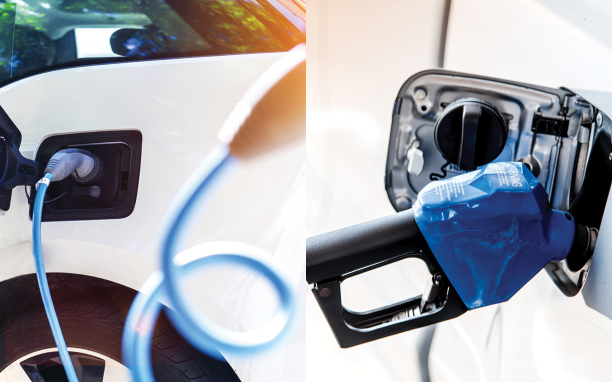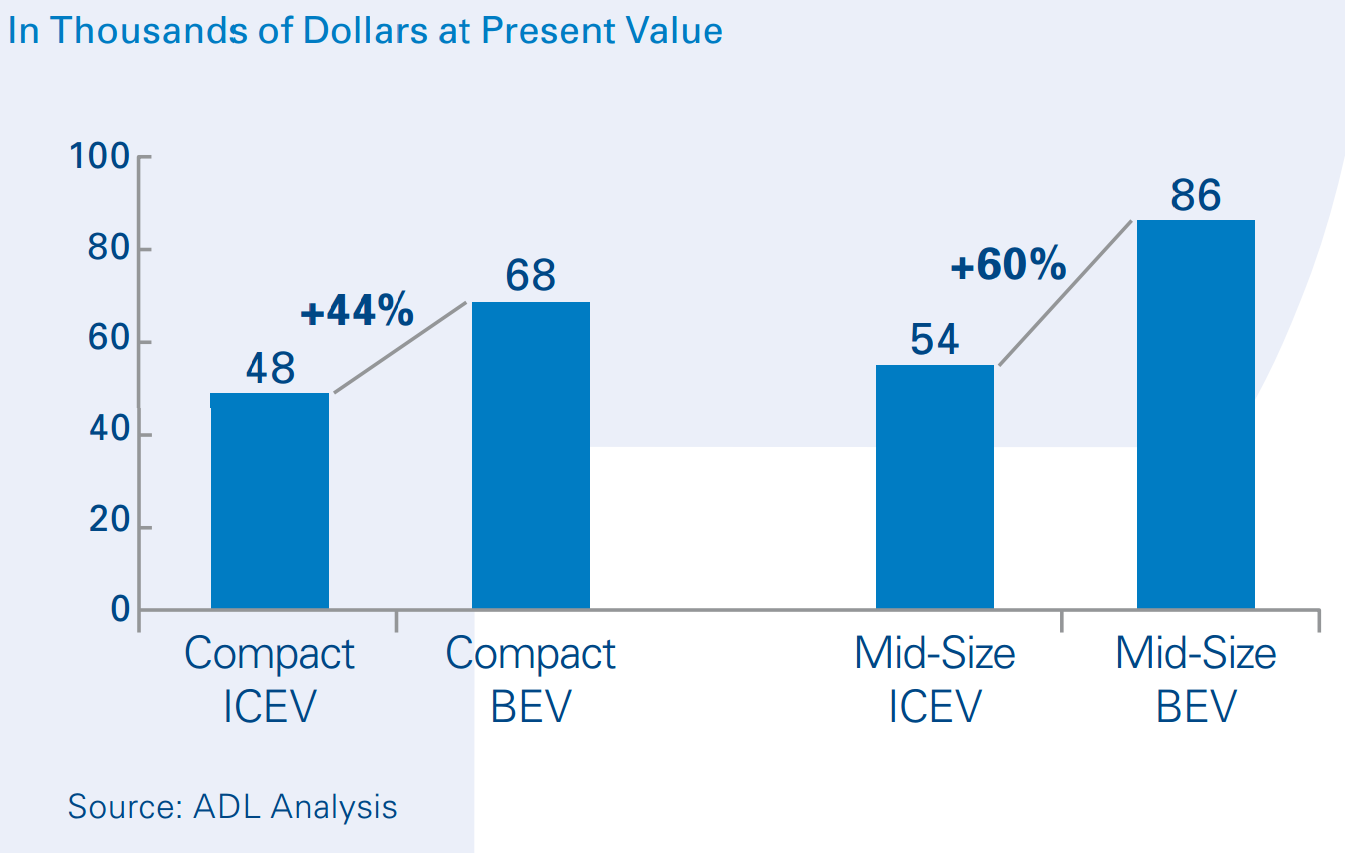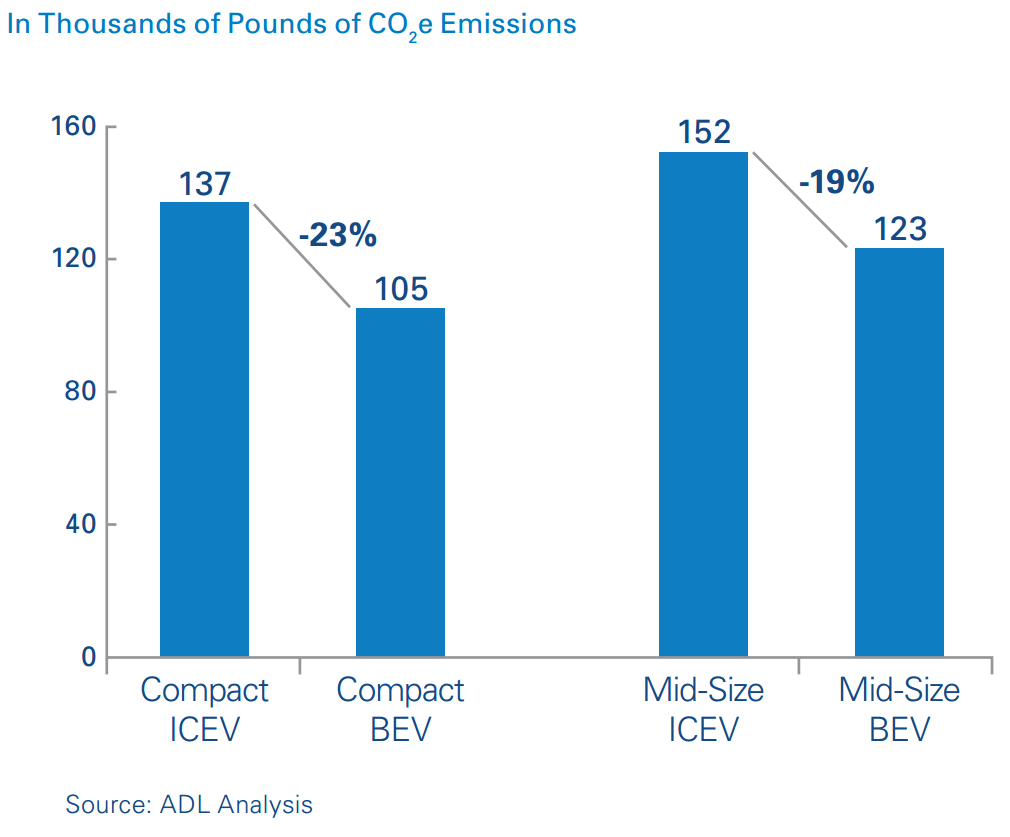
Battery electric vehicles (BEVs) do not consume gasoline or produce tailpipe carbon emissions, placing the promise of an environmentally sustainable driving experience within reach of the average consumer. However, the question remains: “Do BEVs truly offer an environmental advantage with respect to global warming potential and secondary environmental impacts – and if so, at what cost?”
To address this question, Arthur D. Little conducted a total lifecycle economic cost and environmental impact analysis of Lithium-ion battery electric vehicles (BEVs) versus internal combustion engine vehicles (ICEVs) to further understand BEVs and their transformative potential. This study models the relative impacts of new BEVs and ICEVs in the United States for the latest full calendar year for which data is available, 2015, and it projects the economic and environmental impacts of BEVs and ICEVs over the entire assumed twenty-year lifetime for a US passenger vehicle. Given that this is a rapidly evolving market, our study also forecasts the economic and environmental impacts that new BEVs and ICEVs will have in 2025, taking into account salient expected developments in battery technology, vehicle range, and fuel economy standards.
In order to determine the true cost and environmental impacts from BEVs, we performed a comprehensive quantitative analysis excluding any government incentives or subsidies. Our study investigated every stage of the vehicle’s lifecycle, from R&D and production, including sourcing of raw materials, through ownership and end-of-life disposal. We evaluated the impacts associated with each component of the vehicle, from the novel technologies and chemistries involved in battery production to the In-Use energy requirements (i.e., gasoline and electricity, from well-to-wheels) necessary to power a vehicle. We constructed models that calculate the 2015 Total Cost of Ownership (TCO), Global Warming Potential (GWP), and Secondary Environmental Impacts (e.g., Human Toxicity Potential characterized as Disability Adjusted Life Years lost) for BEVs and ICEVs. We also forecast how BEV and ICEV technology will evolve over the coming decade and we leveraged this information to model the 2025 TCO, GWP, and Secondary Environmental Impacts for BEVs and ICEVs.
Based on our study, the ultimate environmental and economic reality of electric vehicles is far more complicated than their promise. From an economic perspective, BEVs enjoy some distinct advantages. First, the electricity cost associated with operating a BEV over a distance of one mile is significantly lower than the gasoline cost required to operate a comparable ICEV over the same distance. Second, BEVs cost less to maintain, owing to the relative elegance and simplicity of a battery-electric motor system compared with the frequent maintenance required for operation of an internal combustion system. Third, automotive battery technology has evolved rapidly since the current generation of BEVs came to market, with the price per kilowatt-hour (kWh) of lithium-ion battery packs declining from $1,126 in 2010 to just $300 in 2015 (see Appendix E-1).
Based on our study, the ultimate environmental and economic reality of electric vehicles is far more complicated than their promise. From an economic perspective, BEVs enjoy some distinct advantages. First, the electricity cost associated with operating a BEV over a distance of one mile is significantly lower than the gasoline cost required to operate a comparable ICEV over the same distance. Second, BEVs cost less to maintain, owing to the relative elegance and simplicity of a battery-electric motor system compared with the frequent maintenance required for operation of an internal combustion system. Third, automotive battery technology has evolved rapidly since the current generation of BEVs came to market, with the price per kilowatt-hour (kWh) of lithium-ion battery packs declining from $1,126 in 2010 to just $300 in 2015 (see Appendix E-1).
Figure 1. Total Cost of Ownership over a 20-Year Lifetime for a 2015 ICEV versus an Equivalent BEV

Battery Electric Vehicles vs. Internal Combustion Engine Vehicles
Figure 2. Greenhouse Gas Emissions over a 20-Year Lifetime for a 2015 ICEV versus an Equivalent BEV

a significant barrier for wider adoption of BEVs and could explain why their market penetration has been limited to date.
From an environmental perspective, the picture is even more complex. BEVs in 2015 achieve the goal of reducing greenhouse gas emissions relative to comparable ICEVs when considered over a vehicle’s lifetime, but this masks an increased human health impact relative to ICEVs and a host of other collateral impacts to the environment (see Figures 2 and 3). While most of the environmental impacts generated by ICEVs are localized to the combustion of gasoline in the vehicle engine, the manufacturing process for BEVs generates a much more widely
Figure 3. Days of Life Impact (Death or Disability) for a 2015 Compact Passenger ICEV versus an Equivalent BEV over 20 Years of Ownership

dispersed and damaging set of environmental impacts, offsetting a significant portion of their overall advantage with respect to greenhouse gas emissions.
In particular, the usage of heavy metals in the manufacture of lithium-ion battery packs for BEVs combined with pollution generated by the US power grid (e.g. tailings from coal power plants) for the In-Use portion of a BEVs lifecycle generate approximately three times the amount of human toxicity compared to ICEVs (see Figure 3). Given the divergence in where environmental impacts are allocated, it is safe to say that a consumer who chooses to drive a BEV over an ICEV shifts the environmental
Figure 4. Comparison of ADL’s Study with Union of Concerned Scientists’ and National Bureau of Economic Research’s Findings

impact of car ownership. As detailed in a recent series of investigative reports by the Washington Post, much of the cobalt and graphite entering the supply chain for lithium-ion batteries is sourced from poorly regulated and heavily polluting mines in Congo1 and China.2 While the BEV driver reduces their local contribution to greenhouse gas emissions, they create a more diffuse set of environmental impacts spread across the globe, the consequences of which are largely borne by rural and often disadvantaged communities near the mines from which BEV suppliers source raw materials for battery pack manufacturing.
As part of our study, Arthur D. Little also presents the findings of two other widely-cited reports on the environmental impact of BEVs versus ICEVs – “Cleaner Cars from Cradle to Grave: How Electric Cars Beat Gasoline Cars on Global Warming Emissions,”3 from the Union of Concerned Scientists (UCS), and “Environmental Benefits from Driving Electric Vehicles?”4 from the National Bureau of Economic Research (NBER). Both of these reports examine the environmental impact of BEVs and ICEVs, and both reports describe the policy implications that arise from their findings. However, UCS and NBER reach drastically different conclusions. We present their divergent findings to frame the broader discussion and situate our study within the larger debate on the true environmental impact of BEVs and ICEVs in the US (see Figure 4).
Forecasting the technological trends for new BEVs and ICEVs in 2025, Arthur. D. Little’s modeling demonstrates that while the TCO differential between BEVs and ICEVs will decline significantly relative to 2015, ICEVs will continue to have an economic advantage ranging from $5,800 to $11,100 (Present Value) relative to BEVs. From an environmental perspective, the differentials in global warming potential and human toxicity potential will both widen in 2025 vis-a-vis 2015: BEVs will produce even lower levels of greenhouse gases relative to ICEVs, but they will generate approximately five times as much human toxicity potential compared to ICEVs due to the utilization of larger battery packs. Combined with the greater financial burden BEVs place on the consumer, the complex environmental reality of BEVs will continue to present challenges for the sustainability-minded consumer in choosing whether to drive a BEV or an ICEV.
